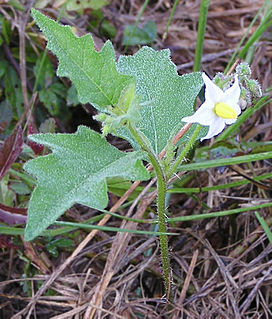
Solanum carolinense, the Carolina horsenettle, is not a true nettle, but a member of the Solanaceae, or nightshade family. It is a perennial herbaceous plant, native to the southeastern United States that has spread widely throughout much of temperate North America. It has also been found in parts of Europe, Asia, and Australia. The stem and undersides of larger leaf veins are covered with spines.

Hibiscus syriacus is a species of flowering plant in the mallow family, Malvaceae. It is native to south-central and southeast China, but widely introduced elsewhere, including much of Asia. It was given the epithet syriacus because it had been collected from gardens in Syria. Common names include the Korean rose, rose of Sharon, Syrian ketmia, shrub althea, rose mallow. It is the national flower of South Korea and is mentioned in the South Korean national anthem.

Nemophila is a genus found in the flowering plant family Boraginaceae.

Nemophila menziesii, known commonly as baby blue eyes or baby's-blue-eyes, is an annual herb, native to western North America.
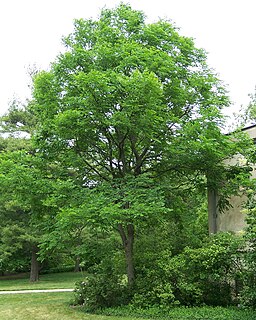
The Kentucky coffeetree, Gymnocladus dioicus, is a tree in the subfamily Caesalpinioideae of the legume family Fabaceae, native to the Midwest and Upper South of North America. The seed may be roasted and used as a substitute for coffee beans; however, unroasted pods and seeds are toxic. The wood from the tree is used by cabinetmakers and carpenters. It is planted as a street tree.

Helianthus is a genus comprising about 70 species of annual and perennial flowering plants in the daisy family Asteraceae. Except for three South American species, the species of Helianthus are native to North America and Central America. The common names "sunflower" and "common sunflower" typically refer to the popular annual species Helianthus annuus, whose round flower heads in combination with the ligules look like the sun. This and other species, notably Jerusalem artichoke, are cultivated in temperate regions and some tropical regions as food crops for humans, cattle, and poultry, and as ornamental plants. The species H. annuus typically grows during the summer and into early fall, with the peak growth season being mid-summer.

Paulownia tomentosa, common names princess tree, empress tree, or foxglove-tree, is a deciduous tree in the family Paulowniaceae, native to central and western China. It is an extremely fast-growing tree with seeds that disperse readily, and is a persistent exotic introduced species in North America, where it has undergone naturalisation in large areas of the Eastern US. P. tomentosa has also been introduced to Western and Central Europe, and is establishing itself as a naturalised species there as well.

Taxodium distichum is a deciduous conifer in the family Cupressaceae. It is native to the southeastern United States. Hardy and tough, this tree adapts to a wide range of soil types, whether wet, salty, dry, or swampy. It is noted for the russet-red fall color of its lacy needles.

Nemophila maculata, with common names fivespot, is a species of flowering plant in the borage family (Boraginaceae).
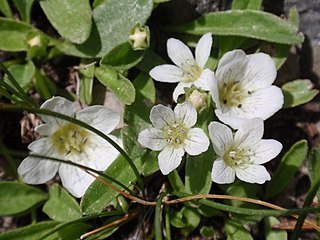
Nemophila spatulata, with the common names Sierra baby blue-eyes and Sierra nemophila, is a dicot in the family Boraginaceae.

Iris giganticaerulea, the giant blue iris, is a species of iris, it is also in the subgenus Limniris and in the series Hexagonae. It is a rhizomatous perennial, from northern America. It has long bright green leaves, very tall stems, 1–2 musky fragrant flowers, in a range of blue shades, from pale blue, to lavender blue, to bright blue, to dark blue, and to violet blue. Rarely, there is a white form.
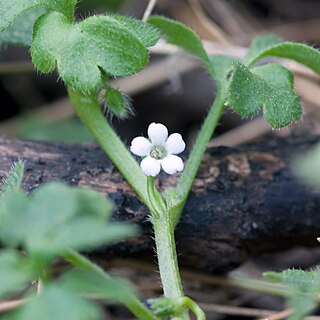
Nemophila aphylla, the smallflower baby blue eyes, is an annual flowering plant in the family Boraginaceae. It is endemic to the southeastern United States and typically found in rich, moist woodlands. It has very small white or pale blue flowers, typically about 0.12 inches wide, that bloom from March to May.
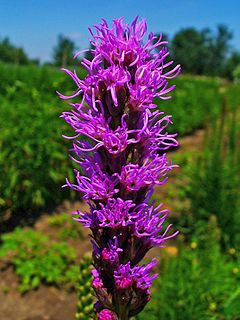
Liatris spicata, the dense blazing star or prairie gay feather, is an herbaceous perennial flowering plant in the sunflower and daisy family Asteraceae. It is native to eastern North America where it grows in moist prairies and sedge meadows.

Collinsia verna, or blue-eyed Mary, is a winter annual that is native to the eastern and central parts of North America but has become endangered in the states of New York and Tennessee. The flowers are bicolored white and blue. It is a plant of valley bottoms and moist bottom slopes, in areas with moderate lighting and requires some shade.
Nemophila breviflora is a species of flowering plant in the borage family known by the common names basin nemophila, Great Basin nemophila, and Great Basin baby-blue-eyes. It is native to southwestern Canada and the northwestern United States, where it generally grows in wooded and forested areas in thickets and moist streambanks.

Nemophila heterophylla is a species of flowering plant in the borage family known by the common name small baby blue eyes.
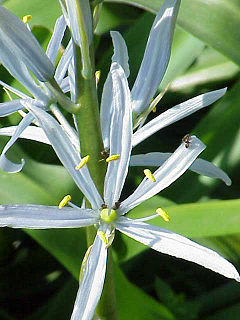
Camassia cusickii, common name Cussick's camas, is a species of plant in the family Asparagaceae. It is native to parts of North America. C. cusickii originally appeared in horticultural journals in the late 1800s, but they been sold and cultivated for about thirty years. This plant family is not studied intensely. Seven or eight species exist in the wild, however, only three are talked about and cultivated.

Rubus flagellaris, the northern dewberry, also known as the common dewberry, is a North American species perennial subshrub species of dewberry, in the rose family. This dewberry is distributed across much of Canada, Mexico, and the United States. It grows in diverse habitats ranging from drier savannas to temperate deciduous forests.
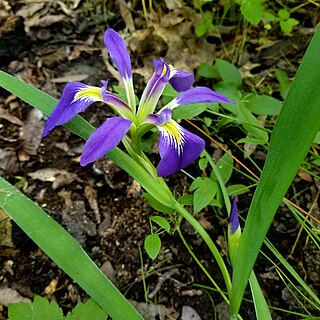
Iris brevicaulis is a species in the genus Iris, it is also in the subgenus Limniris and in the series Hexagonae. It is a rhizomatous perennial, from North America. It has bright green, glossy long leaves, a long zig-zagged stem and 3–6 flowers per stem, which are come in blue shades from violet-blue, to lavender, to purple-blue, to bright blue to blue, and pale blue.

Penstemon cobaea is a flowering plant in the plantain family, commonly known as cobaea beardtongue, prairie beardtongue or foxglove penstemon. The plant is native to the central United States, primarily the Great Plains from Nebraska to Texas, with additional populations in the Ozarks of Missouri and Arkansas. There are also populations reported in the southwestern United States as well as in Illinois and Ohio, but these appear to be introductions.



















